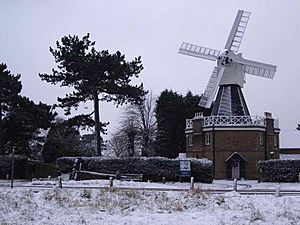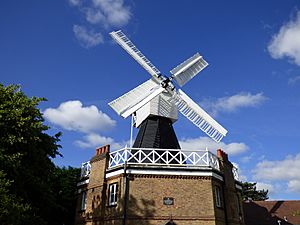Wimbledon Windmill facts for kids
Quick facts for kids Wimbledon Windmill |
|
|---|---|

Wimbledon Windmill, February 2005.
|
|
| Origin | |
| Mill name | Wimbledon Windmill |
| Mill location | Wimbledon Common, London |
| Grid reference | TQ 230 725 |
| Coordinates | 51°26′15″N 0°13′55″W / 51.437622°N 0.232000°W |
| Operator(s) | Wimbledon and Putney Commons Conservators |
| Year built | 1817 |
| Information | |
| Purpose | Corn mill |
| Type | Smock mill |
| Base storeys | Two storey base |
| Smock sides | Eight sides |
| No. of sails | Four |
| Type of sails | Patent sails |
| Windshaft | Cast iron |
| Winding | Fantail |
| Fantail blades | Six blades |
| Other information | Website: wimbledonwindmill.org.uk |
The Wimbledon Windmill is a famous old windmill located on Wimbledon Common in London. It's a special building, officially called a Grade II* listed site, which means it's very important historically. Today, this beautiful windmill is no longer used for grinding grain. Instead, it has been turned into a fascinating museum. Visitors can explore its history and learn all about how windmills work.
Contents
History of Wimbledon Windmill
Building the Mill
In 1799, someone wanted to build a windmill on Wimbledon Common. However, their request was turned down because they didn't show their plans. Years later, in 1816, a carpenter named Charles March asked for permission. He was allowed to build the mill the next year, and it was finished in 1817. This windmill was used to grind corn.
Changes and Challenges
The mill stopped working in 1864. The owner of the land, Earl Spencer, wanted to use the common for himself. The miller, who operated the windmill, was asked to leave. Before he left, he removed most of the mill's machinery. He did this so the Wimbledon Windmill couldn't compete with his other mills nearby. After this, the main mill building was changed. It was rebuilt with bricks to become a place where people could live.
Saving the Common and the Mill
Local people strongly disagreed with Earl Spencer's plans for the common. They worked together to pass a law in 1871. This law, called the Wimbledon and Putney Commons Act, gave control of the common to a group of elected and appointed people. These people are called conservators.
In 1892, the conservators wanted to fix the mill. A company called Messrs. Sanderson & Sons offered to do the repairs for £240. The Royal Wimbledon Golf Club helped by giving £50 towards the cost. During the repairs, they found that the main wooden parts were rotten. So, Sandersons suggested changing the mill into a "smock mill." This would cost £350 in total. The work was finished in November 1893. The original sails were replaced with shorter ones that had fixed shutters. Later, in the 1920s, one sail was lost. A new set of sails with fewer shutters was then put on the mill.
The Mill in Modern Times
During World War II, the windmill was painted a dull green color. This was done to hide it from enemy planes, as there were army camps nearby. One of its sails was also removed. After the war, the mill was repainted. However, the sails stopped turning in 1946 because the gears were too worn out.
In 1952, the mill was checked, and a list of needed repairs was made. People raised money through a public appeal in 1954. Thanks to these funds, the mill was fixed, and its sails turned again on May 25, 1957. The mill was restored once more in 1975 and officially opened as a museum.
In 1999, a special grant from the Heritage Lottery Fund helped restore the sails. This made them able to turn again. The museum, which started on one floor, expanded to two floors in 1999. It tells the story of windmills from their very beginnings to today. You can see models, old machinery, and tools used by millers. One room is kept just as it was when people lived in the mill. Even though it doesn't grind grain anymore, a detailed model shows how the machinery worked in its active days.
On August 2, 2015, one of the sails fell off. This caused damage to the base of the mill. The problem was caused by water getting into the wood over a long time. The sails were repaired and restored in 2016.
How Wimbledon Windmill Works
Wimbledon Windmill was first built as a "hollow post" mill. This meant the machinery that turned the grinding stones went through the middle of a large central post. It worked this way for its entire life as a mill. However, when it was saved and rebuilt in 1893, it was changed into a "smock mill."
The mill has four "patent sails," which are special sails that can adjust automatically to the wind. A "fantail" at the back helps the mill turn to face the wind. The windmill has an eight-sided brick base with two stories. Above this base is a cone-shaped tower. Inside, there used to be the main post.
The strong cast-iron shaft holds the four sails. It also has a large brake wheel, about 6 feet (1.8 meters) across, with wooden teeth. This wheel used to power other gears and shafts. These parts would then turn the millstones on the upper floor, grinding the grain. The company Sanderson's, from Louth, Lincolnshire, did the work to change the mill from a hollow post mill to a smock mill.
Millers Who Worked Here
- Dann – 1840
- A Halloway – 1858
- John Marsh – 1860s
Wimbledon Windmill in Culture
The Mill House at Wimbledon Windmill has a special connection to history. In 1902, Robert Baden-Powell, who started the Scouting movement, stayed there. He wrote parts of his famous book, Scouting for Boys, while at the mill. This book was published in 1908.
The Wimbledon Windmill has also appeared in movies and TV shows. It was seen in a Doctor Who episode called The Massacre of St Bartholomew's Eve (Bell of Doom), which was filmed in 1966. You can also spot it briefly in the 1952 film "Hammer the Toff" and the 1970 Peter Sellers movie Hoffman.
Visiting the Museum
Today, the Wimbledon Windmill is a museum. It teaches visitors about its own story and the general history of windmills. The museum is open on weekends and Bank Holidays from March to October.
Inside, you can find fun, interactive exhibits. There are push-button models that show how things work. You can even try grinding grain yourself! Visitors can also explore the different parts of the actual mill and see how it was used. The windmill and a nearby café are located on Wimbledon Common, surrounded by open spaces and woodlands. It's a great place to learn and explore!


